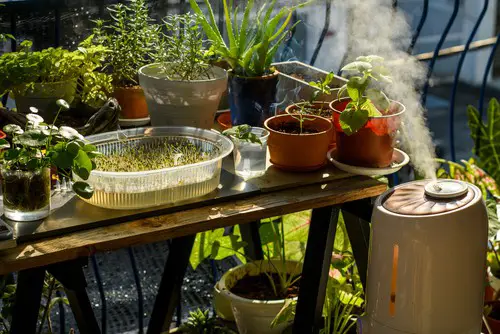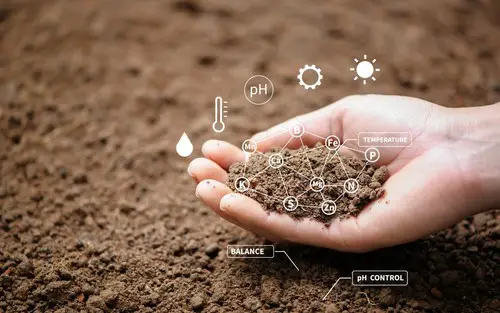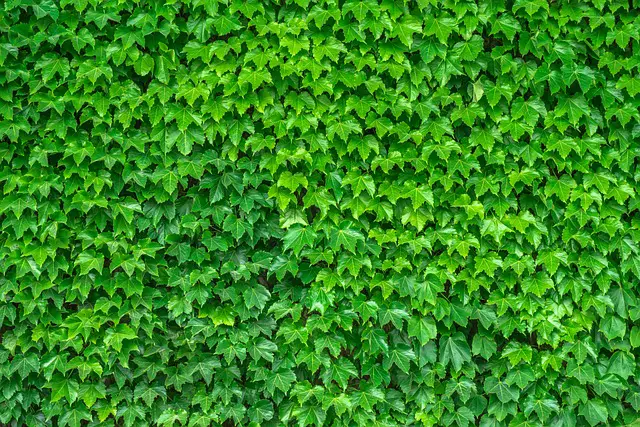Ivy is a popular houseplant known for its lush green foliage that can add a touch of nature to any space. However, if you notice that your ivy leaves are turning brown, it can be a sign that something is wrong.
Ivy Leaves Turning Brown can be caused by several factors, including fungal infection, overwatering, underwatering, low humidity, pests, and poor lighting conditions. Understanding the characteristics of your ivy plant can help you identify the cause of the problem.
Ivy plants prefer indirect bright light and moderate humidity. They also require well-draining soil and regular watering, but overwatering can lead to root rot and brown leaves. Additionally, ivy plants are susceptible to pests like spider mites and mealybugs, which can cause brown spots on the leaves.
If you notice brown leaves on your ivy plant, it is important to identify the underlying cause and take appropriate action to prevent further damage.
Prevention and treatment strategies can include adjusting lighting and humidity conditions, adjusting watering frequency and amount, pruning affected leaves and stems, and using natural pest control methods. With proper care, your ivy plant can thrive and continue to add beauty to your home.
Key Takeaways
- Understanding the characteristics of your ivy plant can help identify the cause of brown leaves.
- Prevention and treatment strategies include adjusting lighting and humidity conditions, adjusting watering frequency and amount, pruning affected leaves and stems, and using natural pest control methods.
- With proper care, your ivy plant can thrive and continue to add beauty to your home.
You will also like:
- Why Are My Dahlia Leaves Turning Brown?
- Why Are My Coral Bells Turning Brown?
- Why Are My Coffee Plant Leaves Turning Brown?
Understanding Ivy Plant Characteristics

Ivy plants are popular indoor plants due to their ability to thrive in low light, their lush green foliage, and their air-purifying properties. Ivy plants are also known for their trailing growth habit, which makes them ideal for hanging baskets or training up trellises.
There are many different types of ivy plants, but the most commonly grown variety is English Ivy (Hedera helix). English Ivy is a hardy plant that can grow in a variety of conditions, including low light and cooler temperatures.
Ivy plants have several unique characteristics that make them easy to identify. These include:
- Leaves: Ivy plants have glossy, green leaves that are typically pointed and have a distinctive shape. The leaves are arranged alternately along the stem and can be either simple or lobed.
- Stems: Ivy plants have woody stems that can be either upright or trailing, depending on the growth habit of the plant. The stems are covered in small, hair-like roots that help the plant attach itself to surfaces.
- Flowers and Fruit: Ivy plants produce small, greenish-yellow flowers in the fall that are followed by black or blue-black berries.
While ivy plants are generally easy to care for, they can develop problems if their growing conditions are not ideal. One common issue that ivy plant owners face is brown leaves. There are several factors that can cause ivy leaves to turn brown, including overwatering, low humidity, and too much direct sunlight.
It’s important to understand the characteristics of ivy plants so that you can provide them with the care they need to thrive. By paying attention to the unique features of your ivy plant and addressing any issues that arise, you can enjoy the beauty and benefits of this popular indoor plant for years to come.
Ivy Leaves Turning Brown – 6 Common Problems
Ivy is a popular houseplant that is easy to care for and adds a touch of greenery to any space. However, if you notice your ivy leaves turning brown, it can be a sign that something is wrong. Here are some common causes of brown ivy leaves and how to fix them.
1. Watering Issues
One of the most common reasons for brown ivy leaves is watering issues. Overwatering can lead to root rot, which can cause brown leaf tips and eventually lead to the entire leaf turning brown. On the other hand, underwatering can cause the leaves to dry out and turn brown as well.
To avoid overwatering, make sure your ivy is planted in well-draining soil and has drainage holes in the pot. Water your ivy only when the top inch of soil feels dry to the touch. To avoid underwatering, make sure your ivy is getting enough water, especially during the growing season.
2. Humidity Factors

Ivy plants prefer high humidity levels, and low humidity levels can cause the leaves to dry out and turn brown. This is especially true during the winter months when indoor heating can dry out the air.
To increase humidity levels, you can mist your ivy with water, place a humidifier near your plant, or group your ivy with other plants to create a microclimate.
3. Soil and Drainage Problems
Poor soil quality and drainage problems can also cause brown ivy leaves. If your ivy is planted in soil that doesn’t drain well, the roots can become waterlogged and lead to root rot. Additionally, soil that lacks nutrients can cause the leaves to turn brown.
To fix soil and drainage problems, make sure your ivy is planted in well-draining soil and has drainage holes in the pot. You can also add fertilizer to the soil to provide your plant with the nutrients it needs.
4. Lighting Conditions
Ivy plants prefer indirect bright light from an east-facing window, or a few feet back from a south- or west-facing window. If placed in too much direct sunlight, your ivy leaves will burn and turn brown. Not enough light can also cause the leaves to turn brown.
To fix lighting problems, make sure your ivy is placed in the right location with the right amount of light. You can also use curtains or blinds to filter out direct sunlight.
5. Temperature Variations
Temperature variations can also cause brown ivy leaves. High temperatures, such as those near a radiator or in direct sunlight, can cause the leaves to dry out and turn brown. Air currents from air conditioning or forced air can also cause the leaves to dry out.
To fix temperature problems, make sure your ivy is not placed near sources of heat or air currents. You can also move your ivy to a cooler location if necessary.
6. Pest and Disease Infestation
Spider mites and fungal diseases can also cause brown ivy leaves. Spider mites are tiny pests that can suck the sap from your ivy, causing the leaves to turn brown and dry out. Fungal diseases can also cause brown spots on the leaves.
To fix pest and disease problems, you can use insecticidal soap or neem oil to get rid of spider mites. Fungal diseases can be prevented by avoiding overwatering and keeping the leaves dry.
Prevention and Treatment Strategies
1. Correct Watering Techniques
One of the primary reasons for brown leaves on ivy plants is overwatering or underwatering. It is important to water ivy plants only when the top inch of soil is dry to the touch.
Using a moisture meter can help to ensure that the soil is not too wet or too dry. It is also recommended to use distilled or rainwater for watering as tap water can contain fluoride and chlorine, which can harm the plant.
2. Maintaining Optimal Humidity
Ivy plants prefer a humid environment, and low humidity levels can cause the leaves to turn brown. One way to increase humidity is to mist the leaves regularly or use a humidifier.
A pebble tray can also be used to increase humidity levels. This involves placing a layer of pebbles in a tray and adding water to the tray. The plant is then placed on top of the pebbles, and the water evaporates, increasing humidity levels around the plant.
3. Choosing the Right Soil and Ensuring Proper Drainage

Ivy plants require well-draining soil to prevent water from accumulating around the roots. A soil mix containing perlite or compost can help to improve drainage. It is important to ensure that the pot has drainage holes to allow excess water to escape.
4. Providing Adequate Light
Ivy plants prefer indirect bright light and can be placed near an east-facing window or a few feet back from a south- or west-facing window. Brown crispy leaves can be a sign that the plant is getting too much light. If the plant is not getting enough light, it may start to stretch towards the light source, causing the leaves to become thin and spindly.
5. Regulating Temperature
Ivy plants prefer cooler temperatures between 50-70°F (10-21°C). High temperatures, especially near radiators, can cause the leaves to dry out and turn brown.
6. Dealing with Pests and Diseases
Pests such as spider mites, mealybugs, and scale insects can cause the leaves to turn brown. A fungicide can be used to treat fungal diseases such as root rot, which can also cause brown leaves. It is important to regularly inspect the plant for signs of pests or diseases and take action promptly to prevent further damage.
Additional Care Tips for Healthy Ivy Plants
Pruning and Repotting
Pruning is essential for maintaining the health of your ivy plant. It helps to remove dead or diseased leaves, promote new growth, and prevent the plant from becoming too leggy. Pruning should be done in the spring or summer when the plant is actively growing. Use clean, sharp pruning shears to make clean cuts just above a leaf node.
Repotting should be done every 1-2 years to ensure that the root system has enough space to grow. Signs that your ivy plant needs repotting include a dying appearance, root rot, or yellow leaves. When repotting, choose a pot that is 1-2 inches larger than the current pot and use a well-draining potting mix.
Dealing with Crispy Leaves

Crispy leaves can be a sign of under-watering or over-fertilization. To remedy this, ensure that the plant is getting enough water and that the soil is well-draining. Avoid over-fertilizing the plant, as this can cause chemical sensitivity and scorching of the leaves.
If the crispy leaves are due to chemical sensitivity, move the plant to a location with better air circulation and avoid using any chemical products around the plant.
Understanding Chemical Sensitivity
Ivy plants are sensitive to chemicals, including pesticides, herbicides, and fertilizers. Chemical sensitivity can cause yellowing of the leaves, die back, and a weakened root system. To prevent chemical sensitivity, avoid using chemical products around the plant and opt for organic alternatives.
In addition to chemical sensitivity, ivy plants require adequate oxygen to thrive. Ensure that the soil is well-draining and that the plant is not over-watered, as this can lead to root rot and a weakened root system.
Frequently Asked Questions
What causes ivy leaves to turn brown and crispy?
Brown and crispy leaves on ivy plants can be a sign of too much light. Ivy plants prefer indirect bright light from an east-facing window, or a few feet back from a south- or west-facing window.
If placed in too much direct sunlight, your ivy leaves will burn. Overwatering is another common cause of brown and crispy leaves. Ivy plants prefer to be kept on the drier side, so make sure to let the soil dry out between waterings.
What are the reasons for ivy leaves turning brown and falling off?
Ivy leaves may turn brown and fall off due to a variety of reasons, including overwatering, underwatering, low humidity, temperature fluctuations, pests, or diseases.
To prevent this, make sure to water your ivy plant only when the top inch of soil is dry, maintain a consistent temperature and humidity level, and keep an eye out for any signs of pests or diseases.
Why are my ivy leaves turning yellow and brown?
Yellow and brown leaves on ivy plants can be a sign of overwatering, underwatering, low humidity, or nutrient deficiencies.
To prevent this, make sure to water your ivy plant only when the top inch of soil is dry, maintain a consistent temperature and humidity level, and fertilize your plant every two weeks during the spring and summer months.
What does it mean when ivy leaves turn black?
Black leaves on ivy plants can be a sign of fungal or bacterial diseases, such as leaf spot or bacterial leaf blight. To prevent this, make sure to maintain a consistent temperature and humidity level, avoid overwatering, and keep an eye out for any signs of pests or diseases.
How do I revive brown ivy?
To revive brown ivy, first identify the cause of the problem. If the issue is due to overwatering, let the soil dry out before watering again.
If the issue is due to too much light, move the plant to a shadier location. If the issue is due to nutrient deficiencies, fertilize your plant every two weeks during the spring and summer months.
Should I prune brown leaves off my ivy plant?
Yes, you should prune brown leaves off your ivy plant. This will not only improve the plant’s appearance but also promote new growth. Use a pair of clean, sharp scissors to trim off the brown leaves and make sure to dispose of them properly.

Hey, I’m Lisa and I’ve been an avid gardener for over 30 years. I love writing, talking and living in the garden! Feel free to connect with me on my socials below


